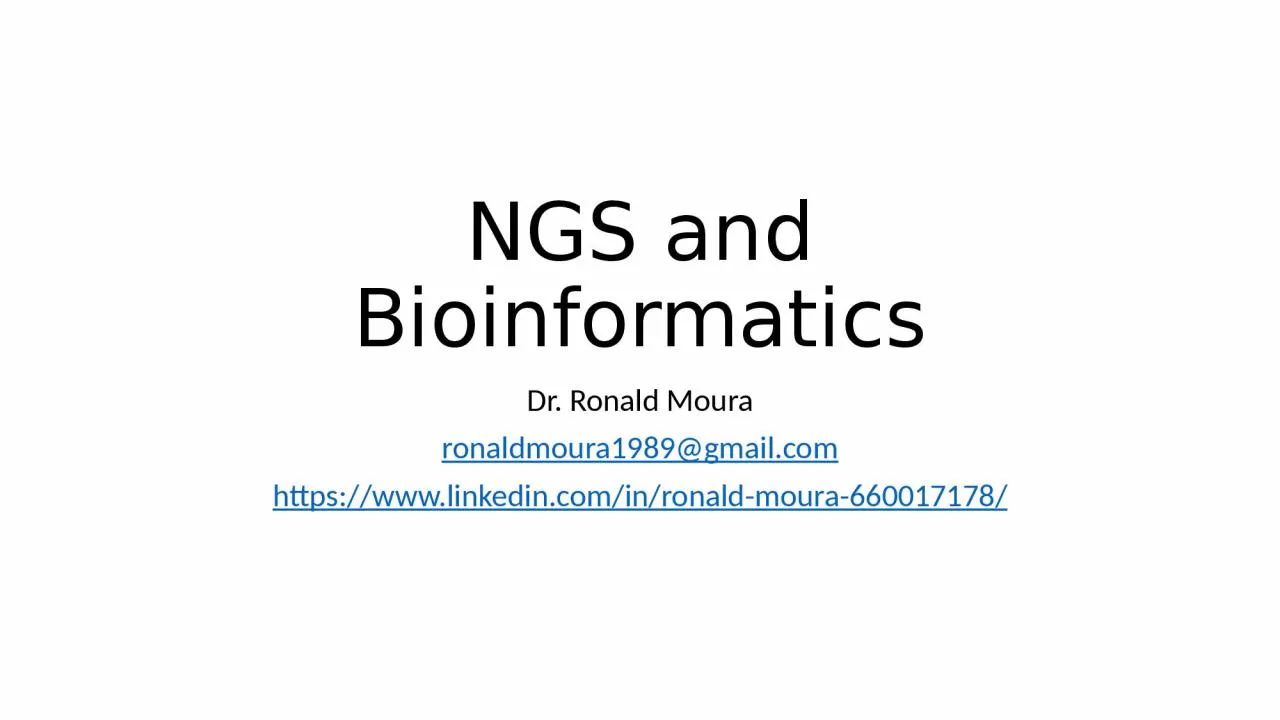

Dr Ronald Moura ronaldmoura1989gmailcom httpswwwlinkedincominronaldmoura660017178 Gordon Moore The number of transistors in a dense integrated circuit doubles about every two ID: 926533
Download Presentation The PPT/PDF document "NGS and Bioinformatics" is the property of its rightful owner. Permission is granted to download and print the materials on this web site for personal, non-commercial use only, and to display it on your personal computer provided you do not modify the materials and that you retain all copyright notices contained in the materials. By downloading content from our website, you accept the terms of this agreement.
Slide1
NGS and Bioinformatics
Dr. Ronald Moura
ronaldmoura1989@gmail.com
https://www.linkedin.com/in/ronald-moura-660017178
/
Slide2Gordon Moore
“The
number of transistors in a dense integrated circuit doubles about every two
years”.
Slide3Human Genome Project
https://
web.ornl.gov/sci/techresources/Human_Genome/project/journals.shtml
Slide4PacBio
Sequencing
Sequencing
Generations
Sanger sequencing
Illumina
Sequencing
NanoPore
Sequencing
Slide5https://www.genome.gov/27541954/dna-sequencing-costs-data
/
Slide6The NGS approach
Whole-genome Sequencing (WGS);
Whole-exome Sequencing (WES);
Targeted Sequencing
;Epigenomics;
Transcriptomics
.
Slide7Some
key
concepts
Read Length:
75, 100, 150 base
pairs
.
Single
and
pair-ended
Reading:Solving
structural rearrangements.Coverage
or Deapth:30x, 50x, 100x, 150x.
Slide8Bioinformatics for NGS
GATK
Slide9Bioinformatics for NGS
Reference genomes:
Species
with reference genomes
Arabidopsis
thaliana
Mus
musculus
(Mouse)
Bacillus_cereus strain ATCC 10987
Mycobacterium
tuberculosis
strain
H37Rv.EB1
Bacillus_subtilis
strain
168
Oryza
sativa
japonica
(Rice)
Bos
taurus (
Cow
)
Pan troglodytes (Chimpanzee)
Caenorhabditis elegans
PhiX
Canis
familiaris
(
Dog
)
Pseudomonas aeruginosa strain PAO1
Danio rerio (Zebrafish)Rattus norvegicus (Rat)Drosophila melanogasterRhodobacter sphaeroides strain 2.4.1Enterobacteriophage lambdaSaccharomyces cerevisiae (Yeast)Equus caballus (Horse)Schizosaccharomyces pombeEscherichia coli strain K12, DH10BSorangium cellulosum strain So_ce_56Escherichia coli strain K12, MG1655Sorghum bicolorGallus gallus (Chicken)Staphylococcus aureus strain NCTC 8325Glycine maxSus scrofa (Pig)Homo sapiensZea mays (Corn)Macaca mulatta
Slide10Bioinformatics for NGS
GATK
Slide11Bioinformatics for NGS
Base Quality Score
Recalibration
(BQSR)
Slide12Bioinformatics for NGS
GATK
Slide13Bioinformatics for NGS
dbSNP 151
Slide14Bioinformatics for NGS
GATK
Slide15Bioinformatics for NGS
Minimum Base Coverage: 10x
Minimum variant
frequency
: 20%
Required
variant
count
: 3
Sufficient
variant
count
: 5
Slide16Bioinformatics for NGS
GATK
Slide17Bioinformatics for NGS
Gene-based
annotation
:
Gene name, a.a. changes,
splicing
sites, etc.
Region
-based
annotation
:
Chromosome
band
, transcription fator binding-site, segmental
duplication, etc.Filter-based annotation
:Presence on dbSNP,
allele frequencies, damaging effect to
protein, etc.
Slide18Bioinformatics for NGS
Protocol
for cancer samples:
Slide19IGV
Slide20NGS in practice
Slide21NGS in practice
Four
years
-old, male
patient;
Diagnosed
with
Fanconi
Anemia;
Complementation
group
was not
identified.
Slide22NGS in practice
Whole-
exome
sequencing;
Pair-ended 100 bp;
Filter
strategy
:
Minimum coverage
of
10 reads;
Variant detection
frequency
of at least 20%;All dbSNP and
silent mutation were excluded;
Low-frequencies
and truncating mutation in FA genes were considered
pathogenic;Unreported non-synonymous
variants were
analyzed for protein damaging effects;
Validation
using Sanger
sequencing.
Slide23NGS in practice
The 10x coverage was
achieved
by 89.70% of
the
targets
;
65,108
SNVs
were
found, being 9,429 in coding
regions;
Slide24Familia Sardenha
ZNF717
Slide25